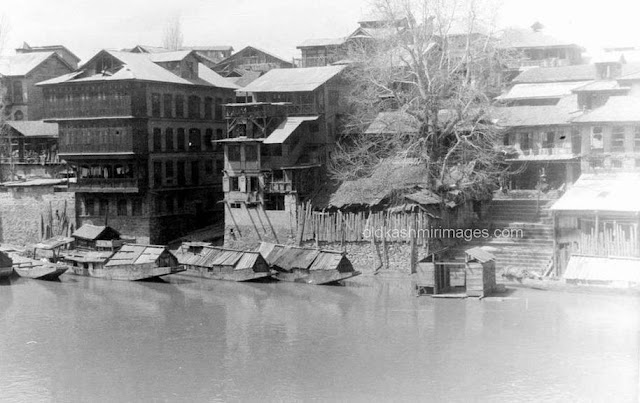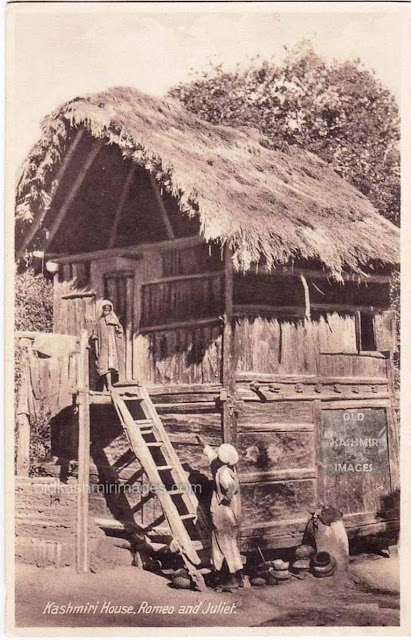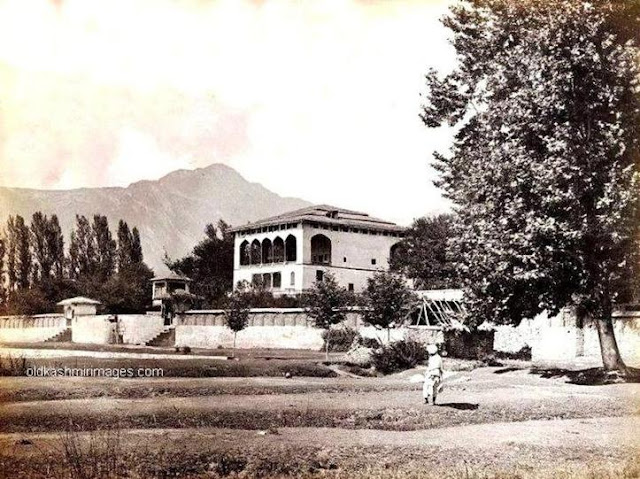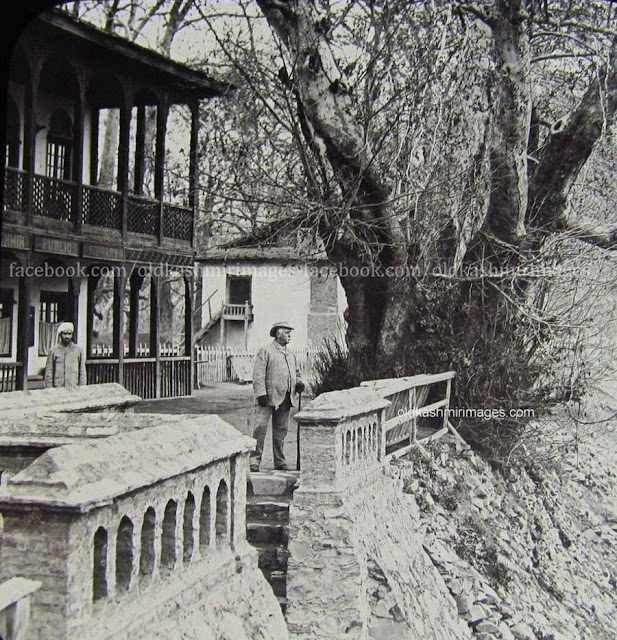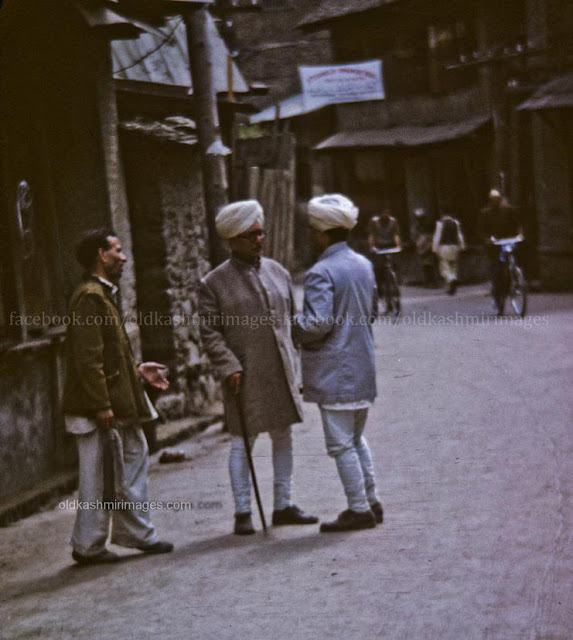Friday, April 5, 2013
KSHATRIYA ( KHATRI ) KASHMIRIS OR KASHMIRI PUNJABIS . PIONEERS OF TRADE AND COMMERCE IN VALLEY
Most of the Kashmiri Punjabis or
the Punjabi kashmiris also known as Khatris ( Kashatriyas ) , who are as good
state subjects as any other kashmiri , had also to move out after the eruption
of Militancy in valley . Presently this miniscule population lies scattered
across the length and breadth of the country . I frequently come cross some of
them. They may be settled financially but they are unsettled psychologically
.Memories of the lost homes/land . Memories of friends , neighbors and
relatives . Memories of Lakes , mountains , springs , brooks , chinars ,
flowers and snow . Tears ,Emotions and sighs .
Some of them had closed down
their business much before the eruption of militancy . Some still continue to
stay in Kashmir but the majority that left
belonged to the land . They also grew sharing its seasons and colours .Their
contribution in various fields is unforgetable . I quote some FIELDS wherein some
of them happened to be the pioneers….
PRINTING
A) BROCA PRINTRING PRESS
(Brocas were the first to install an automatic cutting and rotary printing machine at their Printing workshop.)
(Brocas were the first to install an automatic cutting and rotary printing machine at their Printing workshop.)
PHOTOGRAPHERS OF KASHMIR
A) DATTA STUDIO
B) *MAHATTA STUDIO
C) DARLY PHOTOGRAPHERS
D) PRECO STUDIO
E) ROYAL PHOTOGRAPHERS LAL CHOWK
F) **SURI PHOTOGRAPHERS REGAL CHOWK
(*Mahatta Co And Photographers was started in Kashmir in 1915 by Amar Nath Mehta and His younger brother Ram Nath Mehta . They are Pioneers not only in Kashmir but in Rawalpindi , Murree and Dalhousie. They started the shop from a houseboat . The cannaught Place Mahatta And co (Photography shop) also belongs to this family. Many Locals learnt photography at this shop only. This family is from Gurdaspur Punjab.)
(**I vividly remember Mr Suri Proprietor of the Photographic shop mentioned( at F )above. Suri
sahib was a man of short stature but very agile and active . He was a
perfect photographer . He was always called in for Photo sessions in S P
College where i studied for 3 Years . I vividly remember how he would
stand on his toes to look from the camera lens hiding his head under a
black cloth.He would then rush to the spot where boys and teachers were
seated for the photograph ; Bring people closer , use his hands to
straighten heads and shoulders , rush back to the camera and say " OK ,
ONE TWO AND THREE". Mr Suri was also Connected with Kashmir's Arya Samaj
society )
(*Mahatta Co And Photographers was started in Kashmir in 1915 by Amar Nath Mehta and His younger brother Ram Nath Mehta . They are Pioneers not only in Kashmir but in Rawalpindi , Murree and Dalhousie. They started the shop from a houseboat . The cannaught Place Mahatta And co (Photography shop) also belongs to this family. Many Locals learnt photography at this shop only. This family is from Gurdaspur Punjab.)
HOTELS
1) KHALSA HOTEL AMIRAKADAL SRINAGAR
2) PAHALGHAAM HOTEL ( Sh. Gareeb Singh )
3) PREMIER THE BUND
4) BROADWAY HOTEL ( owned by Amla
family . Late Sh Tirath Ram Amla's family moved to kashmir from Muzaffarbad in
1931 for business . This family also opened BROADWAY cinema in cantonment area
of srinagar )
PETROL AND FUEL
1) LITTLE SONS
2) BAKSHI GURDASS
3) CH.AISHI RAM BATRA AND SONS (Sh. Ch. Aishi Ram Batra, a
renowned businessman and philanthropist hailed from District Multan . Much
Before the partition of the country , the family moved to Kashmir Valley,
where they established in Petroleum business .)
MILK SUPPLIER TO SRINAGAR CITY .
1) GUR DASS MAL
(This firm would bring fresh milk
daily to kashmir in tankers from Amritsar Punjab so as remove scarcity of milk
in the city.. Milk would be then transported in horse carts to entire city from
sonwar where these tankers would park )
WHOLESALE QUALITY MEDICINES
1) BADRI DASS KIDAR NATH
CLOTH MERCHANTS
1 O.
T. C. ( Residency Road )
2 MEHRA
CLOTH HOUSE
3 KAPOOR
CLOTH HOUSE
GOLDSMITHS
1) KHEM SINGH SEWA SINGH ( This
shop was established in 1850 . Another shop with name TARA SINGH AND SONS
jewellers was later carved out from this family shop in hari singh High street srinagar
possibly in 1970. )
2) MEHTAB SINGH JEWELLERS
DOCTORS
1) Dr. S K ATRI ( Grand father of present day doctor with same
name )
2) Dr. MOHAN SINGH
3) Dr. JASWANT SINGH
4) Dr V P SETHI ( first Homeopath of Kashmir )
ICE CREAM IN KASHMIR
A) CAPRI , BUND SRINAGAR.
( I am sure that the first ice cream
softy in Kashmir was sold by this restaurant. Sh karam Vir Anand owned
this business)
BOOK STORES IN KASHMIR
A) KAPOOR BROTHERS ,LAL CHOWK.
B) GIAN CHAND OM PRAKASH / JAI
RAM DASS GIAN CHAND LAL CHOWK.
C) KASHMIR BOOK SHOP ,RESIDENCY ROAD
D) HIND BOOK SHOP ,RESIDENCY ROAD
HALWAI SHOPS IN KASHMIR
A) SANT RAM SOHAL AND SONS
B) AMAR NATH SOHAL AND SONS
C) PRABH DAYAL AND SONS
D) NISHAT SWEETS AMIRA KADAL
E) SHAKTI SWEETS ( Russ Malai was first brought to Kashmir by this shop )
CINEMA HALLS IN KASHMIR
A) PALLADIUM TALKIES , LAL CHOWK.
Bhai Anant singh Gauri was a Businessman who pioneered Cinema in kashmir by opening kashmir's first cinema Hall "Palladium Talkies " in 1932. Ardeshir Irani' Alamara ( produced in 1931) was the first movie screened in this cinema Hall.
When SKIMS was set up at Soura, Bhai Anant Singh donated more than 50 kanals of Land for this premier Medical Centre. The owners of Palladium Cinema were kind and generous to their employees. Bhai Anant Singh kept his cinema Hall at the disposal of National Militia cadres of kashmir in 1947 . The cinema Hall also became HQ of emergency administration post Tribal Attack .
And cinema Halls became immediate targets of Militancy. By January 1990, all cinema halls in Kashmir valley were closed . The historic Palladium cinema looks more like a debris now.
Bhai Anant singh Gauri was a Businessman who pioneered Cinema in kashmir by opening kashmir's first cinema Hall "Palladium Talkies " in 1932. Ardeshir Irani' Alamara ( produced in 1931) was the first movie screened in this cinema Hall.
When SKIMS was set up at Soura, Bhai Anant Singh donated more than 50 kanals of Land for this premier Medical Centre. The owners of Palladium Cinema were kind and generous to their employees. Bhai Anant Singh kept his cinema Hall at the disposal of National Militia cadres of kashmir in 1947 . The cinema Hall also became HQ of emergency administration post Tribal Attack .
And cinema Halls became immediate targets of Militancy. By January 1990, all cinema halls in Kashmir valley were closed . The historic Palladium cinema looks more like a debris now.
B) REGAL TALKIES ,RESIDENCY ROAD
This cinema belonged to BAL family of Raj Bagh/ Gupkar Road .Fashion Designer Rohit Bal is from this Bal family .Rohit Bal studied in Burn hall school srinagar . Bal's clientele list includes noted celebrities like Uma Thurman, Cindy Crawford, Pamela Anderson, Naomi Campbell and Anna Kournikova. Bal opened a flagship store in Delhi, as well as stores in Mumbai, Bangalore, Ahmedabad, Kolkata and Chennai. Bal has also ventured into the designing jewellery.Further Bal family had opened a cinema Hall in Gulmarg as well. This hall was closed during winter season.
( C) AMRISH TALKIES, RESIDENCY ROAD .
Belonged to BAL family of Raj Bagh/Gupkar Road
Belonged to BAL family of Raj Bagh/Gupkar Road
READY MADE GARMENTS SHOP IN KASHMIR
A) DRESS CORNER , LAL CHOWK ( I BELIEVE FIRST Ready made
Garments shop in Kashmir )
DRY CLEANERS IN KASHMIR
A) VIR AND CO, LAMBERT
LANE
B) SUNSHINE DRY CLEANERS , AMIRAKADAL
TRANSPORTERS AND RAIL TICKETING
SERVICES IN KASHMIR
A) N D RADHAKRISHEN AND SONS
B) NANDA BUS SERVICE
C). MUREE KASHMIR. TRANSPORT COMPANY.
WHOLESALE TRADE IN PROVISIONS
( Beopar Mandal Maharaj Ganj srinagar 1932. )
After Maharaja Ranbir Singh established a trading Centre at Maharaj Ganj Srinagar in 1871 , many Punjabi Khatri Traders moved to kashmir and established their trading Shops at Maharaj ganj. It was a wholesale market . Khanna , Kapoor , Chopra , Mehra , Malhotra , Talwar and many Kahtri families from as far as Multan arrived in kashmir at the specific Insistence of Maharaja . They brought a Business/ Trade culture with them and proved of immense help in providing Provisions, Tea , Sugar , Common Salt , Tobacco , Spices , Pulses etc. to kashmiris at Competitive rates . As a matter of fact this Bazaar proved as backbone of kashmir's Trade till nineties of Last century .
HARDWARE
A) KASHMIR METAL MART
C). MUREE KASHMIR. TRANSPORT COMPANY.
WHOLESALE TRADE IN PROVISIONS
( Beopar Mandal Maharaj Ganj srinagar 1932. )
After Maharaja Ranbir Singh established a trading Centre at Maharaj Ganj Srinagar in 1871 , many Punjabi Khatri Traders moved to kashmir and established their trading Shops at Maharaj ganj. It was a wholesale market . Khanna , Kapoor , Chopra , Mehra , Malhotra , Talwar and many Kahtri families from as far as Multan arrived in kashmir at the specific Insistence of Maharaja . They brought a Business/ Trade culture with them and proved of immense help in providing Provisions, Tea , Sugar , Common Salt , Tobacco , Spices , Pulses etc. to kashmiris at Competitive rates . As a matter of fact this Bazaar proved as backbone of kashmir's Trade till nineties of Last century .
HARDWARE
A) KASHMIR METAL MART
These are some of the fields that
come to my mind . I believe these Kshatriya ( Khatris ) did venture in all
fields of trade and commerce . And some of them from Kashmir
landed in Mumbai tomake fellow kashmiris feel proud. I can quote Balraj Sahni ,
Ramanand Sagar , Vidhu Vonod Chopra , Fashion Designer Rohit Bal ,Actor Sanjay
Suri, Cricketer Harish Bahri and many more.
( Harish Bahri ..Ranji Trophy Cricketer from kashmir )
Can we grow together once more
like a FOREST. Grow together as a variety of
plant and trees . Grow like a garden with different flowers . Appear like
smiles on faces . Smiles that shorten distances between human beings . Can we
pass on the prized heritage of peace , happiness and human dignity to our
children ? We who bear the seeds of civilization . We who look towards a new
Dawn.
I conclude above lines with a
poem “SEEDS “ written by my favourite Kurdish poet SHERKO BEKAS …
Seeds
We were millions,
we were old trees,
newly growing plants
and seeds.
From the helmet of Ankara
they came at dawn
they uprooted us
they took us away
far away.
On the way the heads of
many old trees drooped,
many new plants died in the cold,
many seeds were trampled under
foot,
lost and forgotten,
We grew thin like the summer
river,
we diminished like flocks of
birds
towards the time of autumn,
we diminished to mere thousands ,
We had seeds
carried back by the wind,
they reached the thirsty
mountains again,
they hid inside rock clefts,
the first rain,
the second rain,
the third rain,
they grew again,
Now again we are a forest,
we are millions,
we are seeds
plants
and old trees
the old helmet died!
And now you the new helmet
why have you put the head of the
spear
under your chin?
Can you finish us off?
But I know
and you know
as long as there is a seed
for the rain and the wind
this forest will never end?
( sherko Bekas )
(Avtar Mota )





.jpg)






























